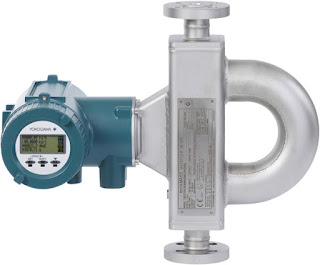 |
| Coriolis flow meter (Yokogawa ROTAMASS) |
Coriolis flow meters are used in a variety of industries ranging from oil and gas, petrochemicals, and food to chemical, life sciences, and — particularly — in transfer applications.
How Does a Coriolis Flow Meter Work?
Coriolis flow meters work on the principle of Coriolis Force that was first explained by a French engineer and mathematician Gaspard-Gustave de Coriolis in the 19th century. The Coriolis force represents an inertial force that acts on bodies in a rotating frame of reference.
Also known as inertial mass flow meters, Coriolis flow meters measure fluid flow through inertia. The device has one or more measuring tubes that vibrate due to the force produced by an actuator. The twisting force inside the measuring tube is directly proportional to the mass flow of the liquid.
 |
| Measurement Principle of the Coriolis Flow Meter (1) (courtesy of Yokogawa) |
The sine waves are in phase with each other when there is no liquid flow. Once the liquid flows through the tube, the measuring tubes twist depending on the mass flow. The sensors detect the extent of the twist by assessing the phase shift in the sine waves. The difference in phase shift helps in determining the mass flow rate.
Volumetric flow is determined by dividing the mass flow rate by the density of the liquid.
Density change is determined by assessing the change in oscillation frequency in response to the excitation inside the tube. The higher the mass flow rate, the lower will be the frequency change and density of the liquid flow.
 |
| Measurement Principle of the Coriolis Flow Meter (2) (courtesy of Yokogawa) |
Lastly, Coriolis flow meters can also be used to measure the temperature inside the tube. The device has sensors inside the tube that can detect temperatures of up to 752 F or 400 C.
The Pros and Cons of Coriolis Flow Meters
Coriolis flow meters can assess liquid flow in both forward and reverse directions. Advanced Coriolis meters have dual curved tubes that can measure with more accuracy. Moreover, the device with curved tubes is characterized by lower pressure drop, making them ideal in specific situations such as wastewater handling, chemical processing, pulp and paper processing, and oil and gas industries.
Another application of Coriolis flow meters is in the pharmaceuticals and food and beverage industries. They can be used with a straight tube design so they are easy to clean. The flow meters are also used in scientific studies for measuring corrosion and assessing liquids and gases. In addition, the flow meters are used in mining operations to monitor liquid flow rate.
While Coriolis meters allow accurate assessment of fluid flow, they are not free from errors. The device can show inaccurate reading when air bubbles are present. The bubbles create splashing that results in generate inaccurate readings. They change the energy required for tube oscillation, resulting in a false assessment of fluid flow.
A lot of energy is spent in the vibration of the tube, especially in case of large spaces. This can also result in failure of accurate assessment of liquid flow inside the tube.
Installation and Calibration of Coriolis Flow Meter
Coriolis flow meter must be installed with full liquid so that no air gets trapped inside the tube. The meter should also be drained completely before use. The ideal location for the flow meter is a vertical pipe mount with an upward flow of fluid.
The Reynolds number is not a limitation with the Coriolis meter. In addition, there is no need for accounting for swirl and velocity profile distortion. As a result, the device can be used without adjusting for straight runs of relaxation piping to condition the liquid flow.
An air release upstream of the meter should be installed if there is a likelihood of air bubbles. In addition, filters, strainers, or air/vapor eliminators can help prevent air bubbles inside the tube. Control valves can also be installed to increase the back-pressure and reduce the likelihood of flashing.
For more information on Coriolis flow meters contact Power Specialties by calling (816) 353-6550 or by visiting https://powerspecialties.com.